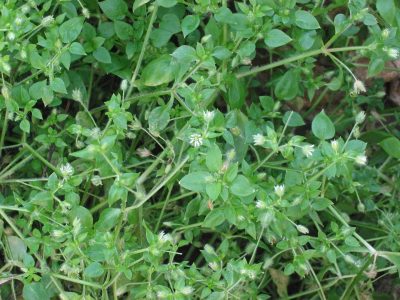By: Troy Weiss, Alaska Master Gardening Student, UAF On-Line, Fall 2017
Description
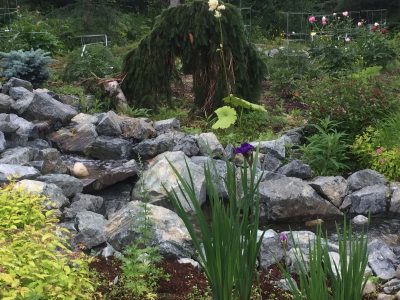 I enjoy gardening because I get satisfaction in watching things grow after I plant it. However, quite often the weeds grow much faster and thicker than my desired plants. In my garden, some common weeds include: 1) horse tail, 2) chickweed, 3) fireweed, 4) shepherds purse, and 5) pineapple weed.
I enjoy gardening because I get satisfaction in watching things grow after I plant it. However, quite often the weeds grow much faster and thicker than my desired plants. In my garden, some common weeds include: 1) horse tail, 2) chickweed, 3) fireweed, 4) shepherds purse, and 5) pineapple weed.
This blog shares research and some management tips associated with common weeds found in my Anchorage garden (Southcentral Alaska). This blog covers the common name, botanical name, life cycle description, and recommended practices for attempting to control the weed in your garden. As you will see from the control methods for these weeds, not all weeds are the same.
Types of herbicides are not recommended in this blog. For information on specific herbicides gardeners should use resources like the Weed Management Handbook, Oregon State University.
Horsetail
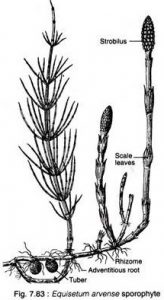
Horsetail (equisetum) is an ancient plant. There are many species with a variety of common names like scouringrush, meadow horsetail (equisetum pretense) and wood horsetail (equisetum sylvaticum).
The plant has two parts: a perennial rhizome and an annual areal shoot. The rhizome spreads laterally underground and lives multiple years. The areal shoot contains a strobilus that spreads millions of spores via air transport if the plant is allowed to mature. (1)
Managing equisetum is challenging because the rhizome breaks when you attempt to pull the plants by hand. The small pieces can live in the ground for years.
The best way I have found to control equisetum is to cut them low using a string trimmer as soon as the plants come up. They definitely need to be trimmed before the strobili forms on top of the plants. Trimming also eliminates sunlight to the plant and delays propagation of rhizomes.
Chickweed
Chickweed (Stellaria media) is an annual plant. Some people eat it on salads, but I personally don’t want it in my garden. For the Lower 48, chickweed sprouts and grows in cool weather or early spring. In Alaska, chickweed is prosperous all summer long.
To control chickweed, websites discuss three different options: pre-emergent herbicide before the seeds germinate, foliage herbicides while growing, and mechanical weeding by hand.
The pre-emergent herbicide should be applied in the fall because the seeds germinate in cold weather. Post-emergent herbicides can be used after the plant is sprouted and growing. For Alaska, this will be May through August. Care must be taken to only spray the chickweed, or other plants may be killed with by-spray. (2)
Fireweed
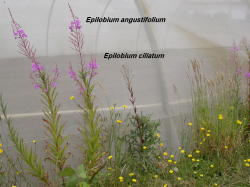
Fireweed (Epilobium chamerion angustifolium) is a perennial plant common in Alaska. Often one of the first plants growing after ground disturbance or wild fire. The plant spreads by rhizomes (spreading roots) or floating seed pods distributed through the wind. The best way to control fireweed is to pull the weeds with as much root as possible; the roots are fairly strong and runners come up easily. They can also be cut down before reaching maturity and spreading seeds. The plant can also be managed with a post-emergent herbicide. (Reference 3), (Image 4)
Shepherds Purse
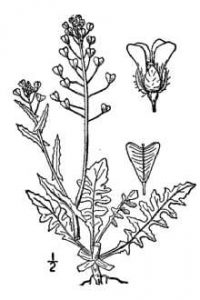
Shepherds purse (Capsella bursa-pastoring) is an annual plant common in colder climates. It reproduces by seed. Each seed pod will contain about 20 seeds, and a single plant will produce about 38,000 seeds. The seeds germinate in the fall. The best control for shepherd’s purse is a pre-emergent herbicide used in the fall before freeze up. (Reference 5), (Image and reference 6)
Pineapple Weed
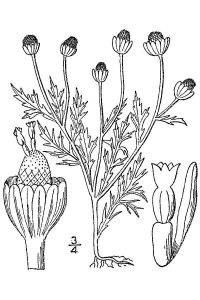
Pineapple weed (Matricaria matricarioide) is an annual plant. It reproduces by seed and is very common in areas with disturbed ground. When crushed, the leaves and flowers smell like sweet pineapple. The plant thrives in thin rocky soil; it can live in high traffic areas like sidewalks or roadsides. The plant blooms from June to July, and the seeds ripen from July to August.
Complete control of pineapple weed is difficult. The root system is shallow, so pulling is an option. Mowing doesn’t slow the plant a bit. Systematic herbicides might be effective. (Image 7), (Reference 8 and 9)
In summary, the best way to control weeds is to understand the plant and its life cycle. I started this research thinking that one of my spreading plants was a weed; however, after using identification software I now believe this plant is foxglove. Foxglove is beautiful, but it is classified as an invasive plant in Southeast Alaska (11). What is obvious from the weed control methods mentioned above is that not all weeds are the same. Some weeds need to be managed with pre-emergent herbicides, some with post emergent herbicides, some weeds need to be mechanically pulled, and some need to be cut before they go to seed. The first step to manage your weeds is to identify the plant, understand its life cycle, do some research, and determine the best plan for your garden.
Sources:
Equisetum: (Image and Reference)
- Neelesh, T. “Equisetum: Habitat, Structure and Reproduction.’ Biology Discussion, 24 Aug. https://www.biologydiscussion.com/botany/pteridophyta/equisetum-habitat-structure-and-reproduction/46033
Chickweed: Reference
2. Teasley, Donna. “Controlling Chickweed.’ NC Cooperative Extension News, https://burke.ces.ncsu.edu/Controlling+Chickweed/
10. Telkamp, Mick. “Make Your Own Natural Weed Killer.’ HGTV, HGTV, 13 July 2017, www.hgtv.com/outdoors/gardens/planting-and-maintenance/make-your-own-natural-weed-killer.
Fireweed:
3. Fleenor, R., 2016. Plant Guide for Fireweed (Chamerion angustifolium). USDA-Natural Resources Conservation Service, Spokane, WA 99201. https://plants.usda.gov/plantguide/pdf/pg_chan9.pdf
4. Photo and Reference: Altland, James. Control and Management of Northern Willowherb Epilobium Ciliatum Angustifolium, https://oregonstate.edu/dept/nursery-weeds/feature_articles/willowherb/willowherb_control_page.htm
Shepherds Purse: Shepherd’s Purse
5. “Agriculture Shepherd’s Purse.’ Province of Manitoba – Agriculture, gov.mb.ca/agriculture/crops/weeds/shepherds-purse.html.
6. Image and Reference: “Capsella Bursa-Pastoris (L.) Medik. Shepherd’s Purse.’ Plants Profile for Capsella Bursa-Pastoris (Shepherd’s Purse), USDA, https://plants.usda.gov/core/profile?symbol=cabu2
Pineapple Weed:
7. Image: “Plant Database: Matricaria Matricardioids.’ Large Image for Matricaria Matricarioides () | USDA PLANTS, USDA Plant Database, https://plants.usda.gov/java/largeImage?imageID=mama11_001_avd.tif
8. Agriculture | Province of Manitoba.’ Province of Manitoba – Agriculture Pineapple Weed, https://www.gov.mb.ca/agriculture/crops/weeds/pineapple-weed.html
9. Dyer, Mary H. “Control Of Pineapple Weed — Learn How To Kill Pineapple Weed Plants.’ Gardening Know How, 30 Jan. 2017, https://www.gardeningknowhow.com/plant-problems/weeds/managing-pineapple-weeds.htm
Foxglove:
11. Invasive Garden Species: Don’t Plant a Problem”, FGV-00146. UAF Cooperative Extension https://www.uaf.edu/wp-content/uploads/sites/541/ces/publications-db/catalog/anr/FGV-00146.pdf
